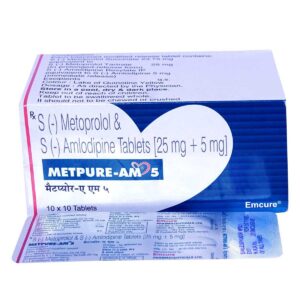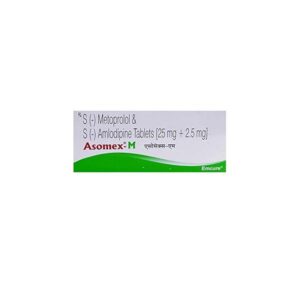S-AMLODIPINE + S-METOPROLOL
S-Amlodipine: S-Amlodipine is a calcium channel blocker and is used to treat high blood pressure (hypertension) and chest pain (angina). The drug works by relaxing and widening the blood vessels, improving blood flow and reducing the workload of the heart.
The recommended starting dose of S-Amlodipine for hypertension is usually 5 mg taken orally once a day. The dose may be adjusted based on individual response, up to a maximum dose of 10 mg per day. For angina, the starting dose is usually 5 mg taken orally once a day, and the maximum dose is also 10 mg per day.
Common side effects of S-Amlodipine may include swelling in the ankles or feet, dizziness, flushing, headache, fatigue, and stomach pain. These side effects are usually mild and go away on their own. However, if any of these side effects persist or worsen, it is important to consult a healthcare professional.
Rare but more serious side effects of S-Amlodipine may include a rapid or irregular heartbeat, chest pain, severe dizziness, and fainting. If these severe side effects occur, immediate medical attention should be sought.
It is essential to follow the prescribed dose and instructions provided by the healthcare professional. S-Amlodipine may interact with other medications, so it is crucial to inform the healthcare professional about any other drugs being taken, including over-the-counter medicines, herbal supplements, or vitamins.
S-Metoprolol: S-Metoprolol is a medication that belongs to a class of drugs known as beta-blockers. It is primarily used in the management of hypertension (high blood pressure), angina (chest pain), and to reduce the risk of heart attacks in patients who have already had a heart attack. It is also sometimes prescribed for the treatment of certain types of arrhythmias (irregular heart rhythms).
The mechanism of action of S-Metoprolol involves blocking the action of adrenaline on the beta receptors in the heart. By doing so, it helps to slow down the heart rate, reduce the force of contraction of the heart, and lower blood pressure.
The dose of S-Metoprolol may vary depending on the individual patient and the condition being treated. Typically, the starting dose for hypertension is 25-100 mg once daily, and it may be increased as needed. For angina, the recommended starting dose is often 50 mg once daily. It is important to follow the dosage instructions provided by the healthcare provider.
Like any medication, S-Metoprolol can cause side effects. Common side effects may include fatigue, dizziness, slow heart rate, low blood pressure, nausea, and cold extremities. Less frequently, it may cause more serious side effects such as shortness of breath, chest pain, swelling of the hands or feet, and fainting. It is important to notify a healthcare professional if these or any other unexpected side effects occur.
It is worth mentioning that the ‘S’ in S-Metoprolol refers to the specific stereoisomer of the drug that is used. This form is considered to be more selective for the beta-1 adrenergic receptors in the heart, resulting in fewer side effects associated with the beta-2 adrenergic receptors found in the lungs and blood vessels. However, the safety and efficacy of S-Metoprolol may vary depending on the individual patient, so it is essential to consult a healthcare provider before starting or changing any medication.



